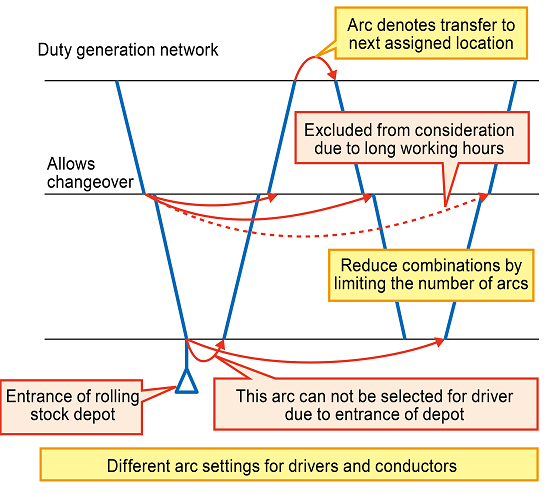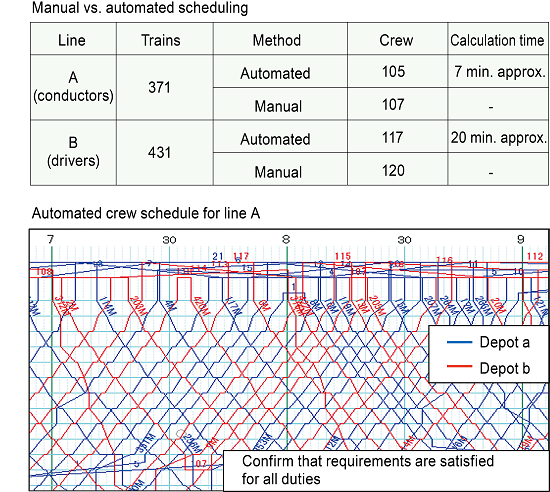14. Automated crew scheduling system
Every timetable revision requires changes to train schedules as well as scheduling of train crews (drivers and conductors) .
The aim of crew scheduling is to maintain train operations in accordance with the relevant conditions and requirements while using the minimum possible number of drivers and conductors.
At present, it takes an experienced scheduling planner days or even weeks to produce a crew schedule for each section of a line, depending on length. Our system automates this process.
Crew scheduling is a two-stage process. First, we design a duty for each crew member with trains assigned to them for each shift. Then we draw up a roster that orders the various duties and incorporates rest breaks at suitable points. Duties are subject to a variety of restrictions and requirements as per the relevant agreements and regulations, including overall work hours, accumulated driving time, and rest and meal times. Rosters are likewise governed by restrictions on hours spent at home and rest days. To date, mathematical optimization techniques have been of limited use, since the number of combinations increases dramatically as more trains are added, making the computation process so complex and time-consuming as to be unfeasible. We have addressed this by introducing network optimization based on graph theory.
By reducing the number of combinations involved, our system is able to generate crew schedules with minimum staffing levels in rapid time. It even takes into account the different restrictions applicable to drivers and conductors (see Figure 1).
Our system, which runs on a standard consumer-level computer, takes no more than about 30 minutes to generate separate crew schedules for driver and conductor sections of a line with around 400 trains per day. This includes duties and rosters that are broadly equivalent to the conventional manually produced versions (see Figure 2).
In addition to efficiency and labor-saving benefits for crew scheduling, the system also helps to reduce reliance on the capabilities of individual workers.
Other Contents
- 9. Integrated analytics platform for railways
- 10. On-board obstacle detection system suitable for low-light conditions
- 11. Tool for estimating bridge deflection from on-board track irregularity measurements
- 12. Wear measuring apparatus for overhead conductor rail using light sectioning
- 13. Imaging analysis method for detecting various anomalies in overhead contact lines
- 14. Automated crew scheduling system
- 15. Fast-track embankment structure for confined settings
- 16. Numerical analysis method for predicting interaction impacts on closely adjacent tunnels
- 17. Method for evaluating girder vibration characteristics with consideration for track rigidity
- 18. Concrete repair methodology based on crack width and location
- 19. Using expansive concrete in track slabs to minimize reinforcement
- 20. Using temperature sensors to help predict service life of electronic signallingequipment
- 21. Effective and efficient steam weeding technique
- 9. Integrated analytics platform for railways
- 10. On-board obstacle detection system suitable for low-light conditions
- 11. Tool for estimating bridge deflection from on-board track irregularity measurements
- 12. Wear measuring apparatus for overhead conductor rail using light sectioning
- 13. Imaging analysis method for detecting various anomalies in overhead contact lines
- 14. Automated crew scheduling system
- 15. Fast-track embankment structure for confined settings
- 16. Numerical analysis method for predicting interaction impacts on closely adjacent tunnels
- 17. Method for evaluating girder vibration characteristics with consideration for track rigidity
- 18. Concrete repair methodology based on crack width and location
- 19. Using expansive concrete in track slabs to minimize reinforcement
- 20. Using temperature sensors to help predict service life of electronic signallingequipment
- 21. Effective and efficient steam weeding technique


